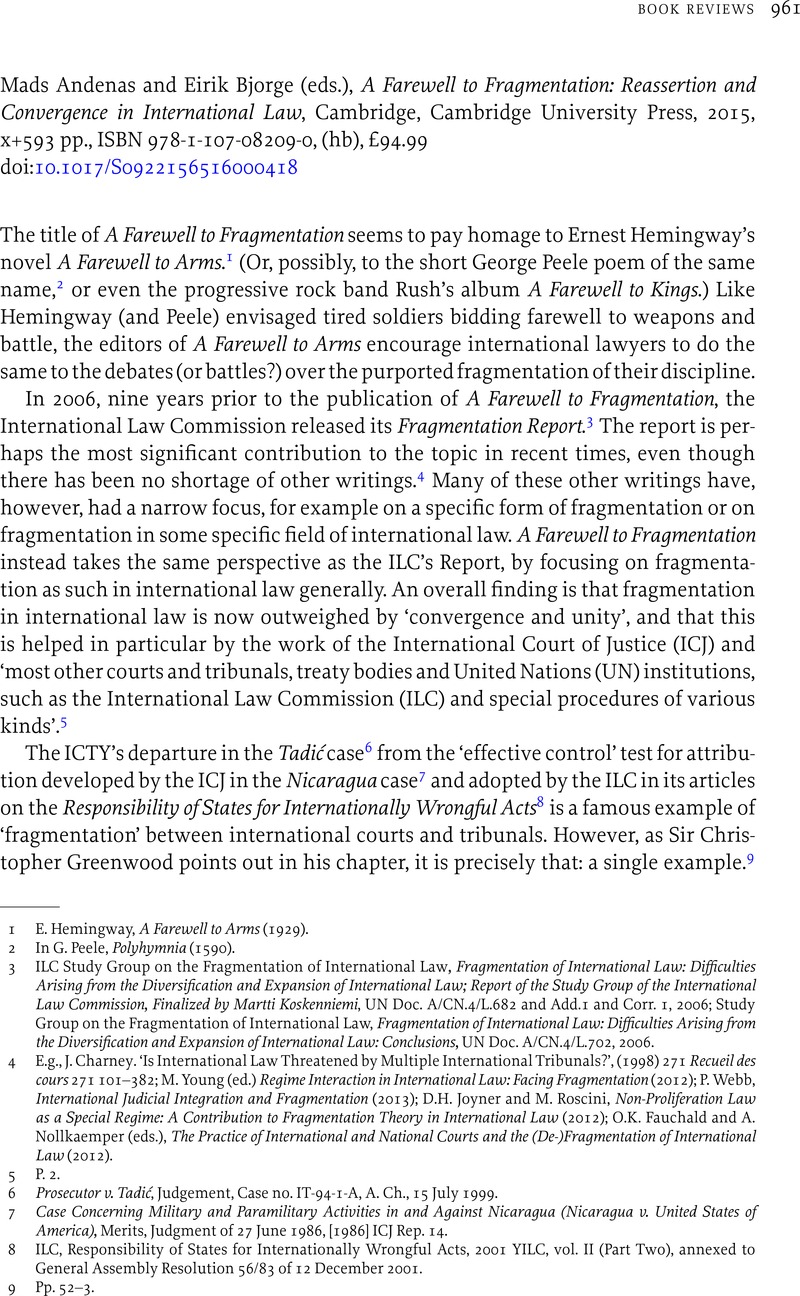Article contents
Mads Andenas and Eirik Bjorge (eds.), A Farewell to Fragmentation: Reassertion and Convergence in International Law, Cambridge, Cambridge University Press, 2015, x+593 pp., ISBN 978-1-107-08209-0, (hb), £94.99
Published online by Cambridge University Press: 28 July 2016
Abstract

- Type
- BOOK REVIEWS
- Information
- Copyright
- Copyright © Foundation of the Leiden Journal of International Law 2016
References
1 E. Hemingway, A Farewell to Arms (1929).
2 In G. Peele, Polyhymnia (1590).
3 ILC Study Group on the Fragmentation of International Law, Fragmentation of International Law: Difficulties Arising from the Diversification and Expansion of International Law; Report of the Study Group of the International Law Commission, Finalized by Martti Koskenniemi, UN Doc. A/CN.4/L.682 and Add.1 and Corr. 1, 2006; Study Group on the Fragmentation of International Law, Fragmentation of International Law: Difficulties Arising from the Diversification and Expansion of International Law: Conclusions, UN Doc. A/CN.4/L.702, 2006.
4 E.g., Charney, J.. ‘Is International Law Threatened by Multiple International Tribunals?’, (1998) 271 Recueil des cours 271 101–382 Google Scholar; M. Young (ed.) Regime Interaction in International Law: Facing Fragmentation (2012); P. Webb, International Judicial Integration and Fragmentation (2013); D.H. Joyner and M. Roscini, Non-Proliferation Law as a Special Regime: A Contribution to Fragmentation Theory in International Law (2012); O.K. Fauchald and A. Nollkaemper (eds.), The Practice of International and National Courts and the (De-)Fragmentation of International Law (2012).
5 P. 2.
6 Prosecutor v. Tadić, Judgement, Case no. IT-94-1-A, A. Ch., 15 July 1999.
7 Case Concerning Military and Paramilitary Activities in and Against Nicaragua (Nicaragua v. United States of America), Merits, Judgment of 27 June 1986, [1986] ICJ Rep. 14.
8 ILC, Responsibility of States for Internationally Wrongful Acts, 2001 YILC, vol. II (Part Two), annexed to General Assembly Resolution 56/83 of 12 December 2001.
9 Pp. 52–3.
10 Sir Rodley, N., ‘The International Court of Justice and Human Rights Bodies’, in Andenas, M. and Bjorge, E. (eds.), A Farewell to Fragmentation: Reassertion and Convergence in International Law (2015), 87 CrossRefGoogle Scholar; V. Gowland-Debbas, ‘The ICJ and the Challenges of Human Rights Law’, in Andenas and Bjorge, ibid., at 109.
11 M. Forowicz, ‘Factors Influencing the Reception of International Law in the ECtHR's Case Law: An Overview’, in Andenas and Bjorge, ibid., at 191.
12 M. Payandeh, ‘Fragmentation Within International Human Rights Law’, in Andenas and Bjorge, ibid., at 297.
13 D. Spielmann, ‘Fragmentation or Partnership? The Reception of ICJ Case-Law by the European Court of Human Rights’, in Andenas and Bjorge, ibid., at 173.
14 V. Fikfak, ‘Reinforcing the ICJ's Central International Role? Domestic Courts’ Enforcement of ICJ Decisions and Opinions’, in Andenas and Bjorge, ibid., at 343.
15 P. Webb, ‘Factors Influencing Fragmentation and Convergence in International Courts’, in Andenas and Bjorge, ibid., at 146.
16 C.A. Miles, ‘The Influence of the International Court of Justice on the Law of Provisional Measures’, in Andenas and Bjorge, ibid., at 218.
17 A. Orakhelashvili, ‘State Practice, Treaty Practice and State Immunity in International and English Law’, in Andenas and Bjorge, ibid., at 407.
18 R. Kolb, ‘Is there a subject-matter ontology in interpretation of international legal norms?’, in Andenas and Bjorge, ibid.; P. Palchetti, ‘Halfway Between Fragmentation and Convergence: The Role of the Rules of the Organization in the Interpretation of Constituent Treaties’, in Andenas and Bjorge, ibid., at 486; E. Bjorge, ‘The Convergence of the Methods of Treaty Interpretation’, in Andenas and Bjorge, ibid., at 498.
19 The convergence effect of the ILC's most important recent work, Responsibility of States for Internationally Wrongful Acts (supra, note 7), may be explored further in a forthcoming book by S. Olleson, State Responsibility before International and Domestic Courts: The Impact and Influence of the ILC Articles (forthcoming).
20 Pp. 165–9.
21 P. 4.
22 P. 6.
23 Pp. 7–12.
24 Statute of the International Court of Justice, 24 October 1945, 188 UNTS 137.
25 1969 Vienna Convention on the Law of Treaties, 1155 UNTS 331.
26 Pp. 473, 484.
27 R.K. Gardiner, Treaty Interpretation (2nd edn., 2015).
28 E. Bjorge, The Evolutionary Interpretation of Treaties (2014).
29 U. Linderfalk, On the Interpretation of Treaties (2007).
30 A. Orakhelashvili, The Interpretation of Acts and Rules in Public International Law (2008).
31 I. Van Damme, Treaty Interpretation by the WTO Appellate Body (2009).
32 J. Romesh Weeramantry, Treaty Interpretation in Investment Arbitration (2012).
33 Pp. 503–5.
- 1
- Cited by


